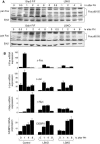Concerted functions of Gab1 and Shp2 in liver regeneration and hepatoprotection
- PMID: 16738330
- PMCID: PMC1489129
- DOI: 10.1128/MCB.02253-05
Concerted functions of Gab1 and Shp2 in liver regeneration and hepatoprotection
Abstract
Liver regeneration is a rapid and concerted response to injury, in which growth factor-generated intracellular signals result in activation of transcription factors, DNA synthesis, and hepatocyte proliferation. However, the link between cytoplasmic signals resulting in proliferative response to liver injury remains to be elucidated. We show here that association of Gab1 adaptor protein and Shp2 tyrosine phosphatase is a critical event at the early phase of liver regeneration. Partial hepatectomy (PH) rapidly and transiently induced assembly of a complex comprising Shp2 and tyrosine-phosphorylated Gab1 in wild-type hepatocytes. Consistently, liver-specific Shp2 knockout (LSKO) and liver-specific Gab1 knockout (LGKO) mice displayed very similar phenotypes of defective liver regeneration triggered by PH, including blunted extracellular signal-regulated kinase 1/2 (Erk1/2) activation, decreased expression of immediate-early genes, and reduced levels of cyclins A, E, and B1, as well as suppression of hepatocyte proliferation. In contrast, the Akt and interleukin-6/Stat3 pathways were up-regulated posthepatectomy in LSKO and LGKO mice, accompanied by improved hepatoprotection. Collectively, this study establishes the physiological significance of the Gab1/Shp2 link in promoting mitogenic signaling through the Erk pathway in mammalian liver regeneration.
Figures







References
-
- Aldeguer, X., F. Debonera, A. Shaked, A. M. Krasinkas, A. E. Gelman, X. Que, G. A. Zamir, S. Hiroyasu, K. K. Kovalovich, R. Taub, and K. M. Olthoff. 2002. Interleukin-6 from intrahepatic cells of bone marrow origin is required for normal murine liver regeneration. Hepatology 35:40-48. - PubMed
-
- Bard-Chapeau, E. A., A. L. Hevener, S. Long, E. E. Zhang, J. M. Olefsky, and G. S. Feng. 2005. Deletion of Gab1 in the liver leads to enhanced glucose tolerance and improved hepatic insulin action. Nat. Med. 11:567-571. - PubMed
-
- Bardin, A. J., and A. Amon. 2001. Men and sin: what's the difference? Nat. Rev. Mol. Cell Biol. 2:815-826. - PubMed
-
- Bladt, F., D. Riethmacher, S. Isenmann, A. Aguzzi, and C. Birchmeier. 1995. Essential role for the c-met receptor in the migration of myogenic precursor cells into the limb bud. Nature 376:768-771. - PubMed
-
- Blindenbacher, A., X. Wang, I. Langer, R. Savino, L. Terracciano, and M. H. Heim. 2003. Interleukin 6 is important for survival after partial hepatectomy in mice. Hepatology 38:674-682. - PubMed
Publication types
MeSH terms
Substances
Grants and funding
LinkOut - more resources
Full Text Sources
Molecular Biology Databases
Miscellaneous
